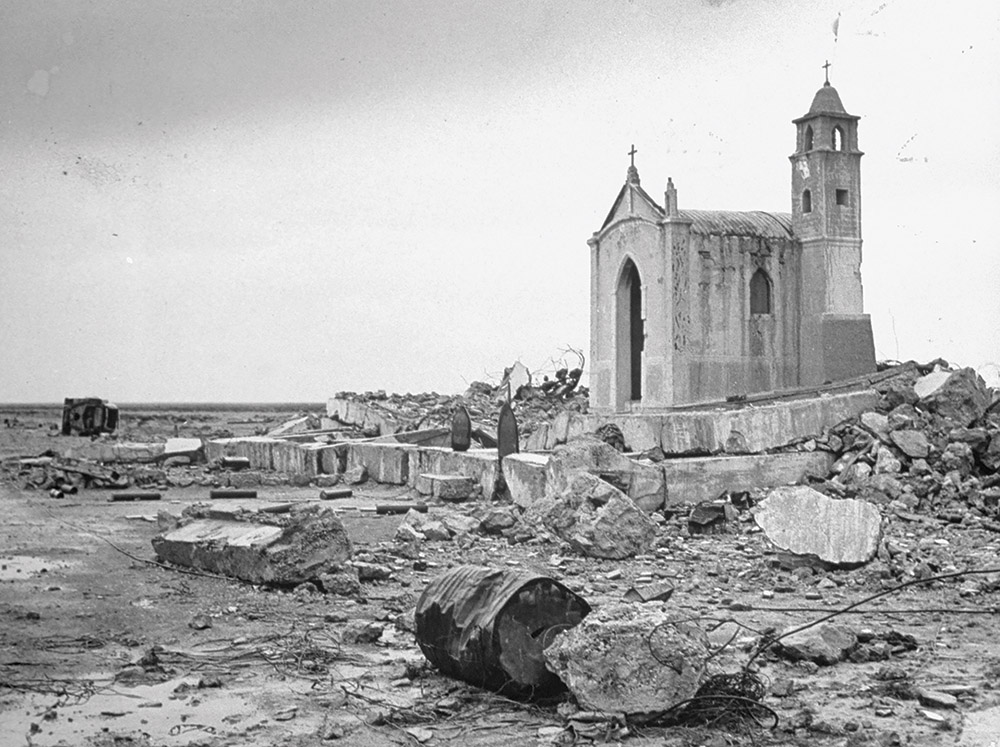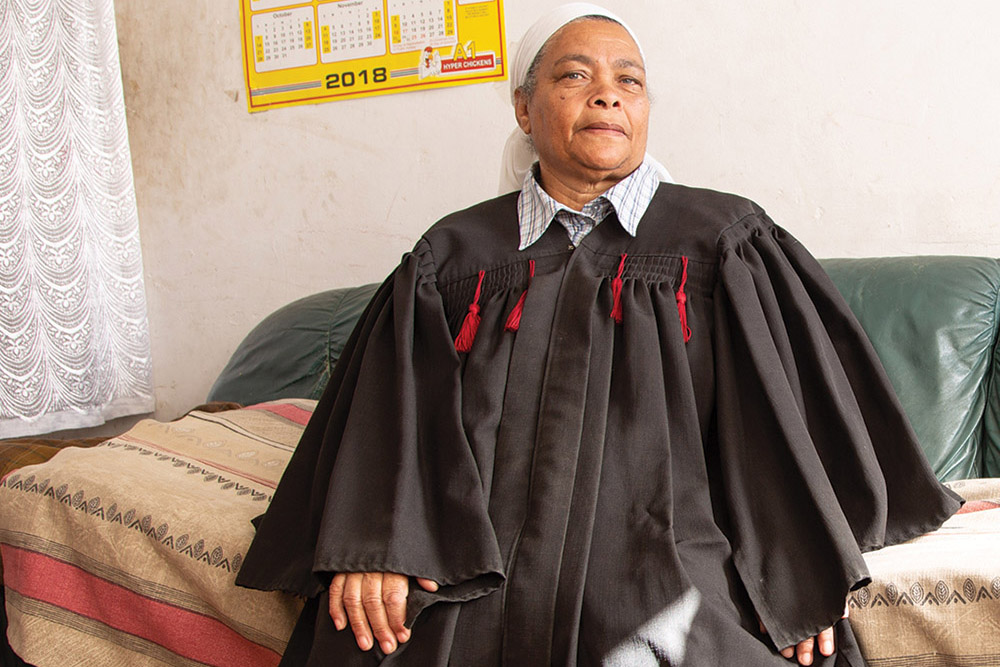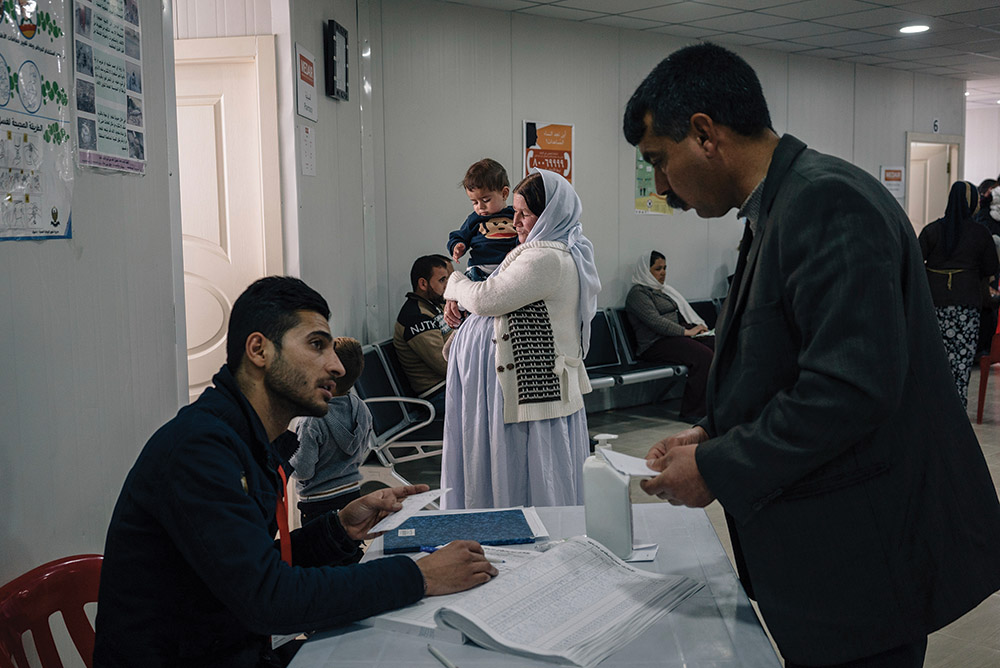Mass Violence and Atrocities | Selected Article
Coming Together: Mental Health and Psychosocial Support in Peacebuilding
A key part of the Stanley Center's strategy to prevent mass violence and atrocities is to channel evidence into policymaking to foster sources of resilience within communities. Within the fields of research and practice of peacebuilding and mass violence prevention, societal and individual mental health is often overlooked, yet remains a critical area for further partnership, analysis, and evidence-based policy integration.
Download“My father was a soldier. He served in Tobruk, Libya, where the second South African Infantry Division was based. We weren’t very rich. My father was a strange man because he came from the war and wasn’t a very normal father. And he always used to tell us stories of his prisoner of war days. Sometimes he would stop because it was too traumatizing for him. He said that in Tobruk they shot people and hung the children from the windows and so on. He couldn’t get over that, so then he drank. And a father that drinks is something else. We were scared of him, to tell you the truth.”
Excerpt from Maria Julius’s story in These Are the Things That Sit with Us, ed. Pumla Gobodo-Madikizela, Friederike Bubenzer, and Marietjie Oelofsen (South Africa: Jacana Media, 2019)

(The LIFE Picture Collection/Getty Images/Bob Landry)
War and violent conflict destroy so much more than infrastructure, livelihoods, and human security. War and violent conflict reach deep into the fabric of society, destroying link after link of this interconnected chain until that chain is weakened and only threads remain. If indeed a chain is as strong as its weakest link, then the individual—within relationships, families, and communities—must be regarded as the starting point for postconflict repair. That is not to say that mental health and psychosocial support efforts need to happen at the individual level. This would be contrary to the communal cultures of many conflict-affected countries such as South Sudan, the Democratic Republic of Congo, Afghanistan, Iraq, and Syria—and it would be unrealistic given the scale of the need. Focusing efforts at the individual level would also negate inherent human resilience; communal and collective psychosocial interventions can go a long way in restoring damaged social fiber, especially when paired with economic development. What it does say is that we must recognize how witnessing and experiencing violent conflict and its vast social, economic, and political ramifications has a detrimental effect on the well-being of and the relationships among human beings. Deliberate and coordinated efforts among international humanitarian agencies, policymakers, and local institutions are essential to prevent feelings of hatred, fear, and mistrust from spiraling into deeper cycles of violence.

Photo by Botswele Mogotlane
Narrowing the Gap
It has been just over five years since we at the Institute for Justice and Reconciliation (IJR) in South Africa and the War Trauma Foundation (WTF) in the Netherlands (now Arq International) joined hands on a project aimed at narrowing the gap between the fields of peacebuilding (PB) and mental health and psychosocial support (MHPSS). The underlying premise of the project is that sustainable peacebuilding and mental health and well-being are interdependent and critical to effective and long-term violence prevention. What we did not know at the beginning was that the project would draw in a variety of interested people at every opportunity–whether at conferences, on webinars, or via Skype. There is no doubt in my mind that the enthusiasm we have faced during all phases of this project have been directly related to the urgency of the matter at hand.
A 2019 article published in the Lancet and containing data from the World Health Organization shows that 22.1 percent of people living in conflict-affected areas have depression, anxiety, posttraumatic stress disorder, bipolar disorder, or schizophrenia. These new estimates—generated by systematic reviews of vastly increased pools of data using state-of-the-art methods—are even higher than previous estimates. The authors rightly argue, “The well-established links between mental health, individual functioning, and country development underscore the imperative to prioritize mental health care in countries affected by conflict.”
Coming to Terms
We must also understand that individuals who have been affected by conflict are less likely to engage in peacebuilding, meditation, and development initiatives, especially where mental health challenges have not been addressed and relationships repaired. Therefore, it is unrealistic to expect people to participate effectively in dialogue and conflict-resolution initiatives—however creative and context-specific these may be—without first helping them come to terms with their traumatic past. Cutting-edge research conducted by TPO Uganda, a nongovernmental organization (NGO), provides important new data in this regard. Its study examined the precise relationship and intersection between postconflict trauma, peacebuilding, and economic development. The authors of the report, Marian Tankink and Ben Otto, explain, “Without exception, all (237) respondents stated that reconciliation and peacebuilding are impossible if only an individual’s trauma symptoms are addressed, such as nightmares, depression, lack of trust and fear.” They note that mental health problems related to their daily stressors must also be managed. Strikingly, the report quotes a male community support worker in northern Uganda as saying:
“If you do mediation but you do not address the mind of the people, that means there is a high chance that the people continue conflict, and in their livelihood they will not manage well. But by first addressing the mind of the people you are building peace and a good relationship between people and at the end of the day, the conflicts will go down. That is the best way to address peace.”
A Need for Evidence and Guidance
While it bodes well for the field that studies like this one are now being conducted, very little other evidence-based research currently exists. At the time of the IJR-WTF conference in 2015, few studies were found that explored how the fields of MHPSS and peacebuilding might be brought together in theory and practice. In 2014, Brandon Hamber, Elizabeth Gallagher, and Peter Ventevogel edited a special section of the journal Intervention that argued that greater attention should be given to the synergies that could be created by linking psychosocial work with processes of social change and communal recovery within the context of collective violence and humanitarian emergencies. Participants at the IJR-WTF conference suggested much more research be done to develop a theory of change and an evidence base for the need to integrate the fields. The IJR and WTF followed suit: in 2017, an extensive literature review was published that revealed how few studies were linking MHPSS and PB from the outset and in an ecological way to impact society at micro, meso, and macro levels. In 2018, an IJR international mapping study of over 70 organizations from around the world working in either mental health or peacebuilding presented an interesting lay of the land: 92 percent of respondents agreed that interventions aimed at building sustainable peace would benefit from an approach that connects peacebuilding and mental health. The same respondents also said that by and large they did not have the resources or the knowledge to implement it, nor the networks to collaborate with the corresponding field.
A cursory review of the major international policy documents that guide global peacebuilding efforts in postconflict societies reveals almost no reference to or consideration of the mental health and psychosocial well-being of affected individuals and communities. This guidance is particularly lacking for African contexts, where the IJR’s work is focused. For example, in 2019, the African Union adopted a Transitional Justice Policy, and while the policy is a solid document that clearly and concisely lays out the key elements, actors, processes, and implementation mechanisms necessary to contribute to rebuilding African societies torn apart by violent conflict, it makes only tangential reference to MHPSS and mostly only in reference to the needs of women and children.

(AP/Alice Martins)
Signs of Action
Thankfully, efforts are underway to bridge these shortcomings of guidance. In an important and widely distributed 2019 Guardian article, Sigrid Kaag, the Dutch minister for foreign trade and development cooperation, made the case for the urgent provision of MHPSS to conflict-affected communities around the world. She argued: “Children growing up in a war become a wounded generation. They suffer the loss of human dignity. A generation that is itself unstable has trouble passing on stability to their own children. This means that a community can never move on. Trauma and severe mental distress do not just go away.” Kaag is increasingly being viewed as an ambassador and advocate for MHPSS in humanitarian and postconflict settings, and it is hoped that others will join her lead in giving this critical topic enhanced political visibility and airtime, especially at a global political level.
Efforts are also underway by the Dutch Ministry of Foreign Affairs to coordinate an international-expert-group-led contribution to the 2020 regular review of the UN Peacebuilding Architecture. Titled Mind the Past to Build the Future, the initiative aims to raise international political awareness of and support for the need for MHPSS as an integral part of peacebuilding and to prepare recommendations to initiate systemic changes of the UN Peacebuilding Architecture needed to increase the ability to integrate MHPSS in its work.
The Inter-Agency Standing Committee, an interagency forum of UN and non-UN humanitarian partners founded in 1992 to strengthen humanitarian assistance, has also created a working group on this topic. Constituting more than a dozen international NGOs, the group aims to establish a high-level framework for the improved integration of MHPSS into concepts and measures addressing the prevention of violent conflicts and vice versa. While focused on MHPSS, the working group is taking into account the complexities and diversities of both the MHPSS and the PB disciplines, assuming that enhanced well-being and sustainable peace will be achieved through a coherent framework and joint approach.
Unifying the Approach
These high-level efforts, especially those taking place at a policy level, are critical but must be expanded and coordinated to ensure inclusivity and equitable representation, especially where the north-south divide is concerned. High-level efforts must also be enhanced by smaller local NGOs that collect and transfer community-level insights to policymakers. Some examples of these integrative opportunities include efforts by civil society. In 2019, the Alliance for Peacebuilding, a US-based network of organizations working to end conflict, reduce violence, and build sustainable peace, and Generations for Peace, a Jordanian NGO dedicated to peacebuilding through sustainable conflict transformation, came together to host an international advocacy webinar on the topic that was attended by hundreds of practitioners, policymakers, and academics from both the MHPSS and PB fields from around the world. While the primary aim of the webinar was to explain the need to link the fields, participants also asked for links to existing research and best practices in order to advocate for integration within their spheres of influence. Shortly thereafter, MHPSS.net—a resource and knowledge-sharing network—partnered with TPO Uganda and the IJR and hosted another webinar specifically profiling more-localized community efforts with a focus on Africa. As mental health is increasingly considered a critical component of public health, and as the psychosocial impact of violent conflict on affected communities is better researched, understood, and publicized, practitioners, academics, and policymakers around the world are realizing the importance of working together and linking the fields.
It is hugely exciting to see more and more organizations and institutions acknowledge that there is no peace without mental health and healthy relationships, and that unaddressed mental health challenges pose serious threats to violence prevention and living in peaceful coexistence. That said, a holistic approach requires that practitioners from both fields be brought together in practice to jointly imagine collaboration and, eventually, integration. Mere add-on approaches that continue a mostly siloed collaboration framework are unlikely to generate the kinds of preventative outcomes postconflict countries so urgently need. In 2019, the IJR hosted three cocreation workshops with local partners in Johannesburg, South Africa; Nairobi, Kenya; and Harare, Zimbabwe. Each workshop was attended by an equal number of MHPSS and peacebuilding practitioners. As a result, significant strides were made in working together across disciplines to lay the foundation for an integrated approach based on local needs and contextual nuances. As one cocreation workshop participant said, referencing the African philosophy of compassion and humanity: “For people to completely heal, they need peace. Healing is a process and according to ubuntu, I am healed if my neighbor is healed. And for this, peacebuilding is necessary. Development, peacebuilding, and trauma recovery is important—like three pieces of a pot. Without one, the person is unstable.” The creation of a draft handbook is underway that is anticipated to be used for a pilot training of an integrated approach to MHPSS and PB in late 2020.
Maria Julius ends her story by saying, “We did love him [our father], but I was fearful of him. At Christmas, when it was time for carols, then we marched around the table singing, all of us.”
Since Maria Julius’s father served in the Second World War, the world has come a long way in understanding and addressing the human cost of violent conflict. Still, we have a long way to go to ensure that the rebuilding of the human spirit is prioritized alongside other humanitarian and peacebuilding efforts.
Friederike Bubenzer is Senior Project Leader in the Peacebuilding Interventions Programme at the Institute for Justice and Reconciliation, South Africa.
References
African Union. Transitional Justice Policy. Addis Ababa, Ethiopia: 2019. https://au.int/sites/default/files/documents/36541-doc-au_tj_policy_eng_web.pdf.
Bubenzer, F., and M. Tankink. Healing Communities, Transforming Society: Exploring the Interconnectedness between Psychosocial Needs, Practice and Peacebuilding. Cape Town, South Africa: Institute for Justice and Reconciliation and the War Trauma Foundation, 2015. http://www.ijr.org.za/portfolio-items/conference-report-healing-communities-transformingsociety.
Bubenzer, F., and M. Tankink. “Introduction to Special Issue: Linking Mental Health and Psychosocial Support to Peacebuilding in an Integrated Way.” Intervention 15, no. 3 (2017): 192-198.
Bubenzer, F., S. Van der Walt, and M. Tankink. Mapping Global Practice: Healing Communities, Transforming Society, Mental Health, Psychosocial Support and Peacebuilding. Cape Town: IJR and War Trauma Foundation, 2017.
Charlson, F., M. van Ommeren, A. Flaxman, J. Cornett, H. Whiteford, and S. Saxena. “New WHO Prevalence Estimates of Mental Disorders in Conflict Settings: A Systematic Review and Meta-Analysis.” Lancet 394, no. 10194 (2019): 240-248.
Hamber, B., E. Gallagher, and P. Ventevogel. “Narrowing the Gap Between Psychosocial Practice, Peacebuilding and Wider Social Change: An Introduction to the Special Section in This Issue,” Intervention 12, no. 1 (2014): 7–15.
Kaag, S. “War’s Trauma Endures Long After the Last Shot Is Fired—Broken Souls Need Rebuilding. Guardian.” June 30, 2019. https://www.theguardian.com/society/2019/jun/30/wars-trauma-endures-long-after-the-last-shot-is-fired-broken-souls-need-rebuilding#img-1.
Tankink, M., and B. Otto. “Peace Starts with Peace of Mind”: Study on the Intersection between Post-Conflict Trauma and Peacebuilding in Northern Uganda. Research report. Kampala, Uganda: TPO Uganda, 2019
Related Publications
Mass Violence and Atrocities
Coming Together: Mental Health and Psychosocial Support in PeacebuildingMass Violence and Atrocities
Jai-Ayla Sutherland Testimony Before Tom Lantos Human Rights CommissionMass Violence and Atrocities
Taking Stock of the Evidence: What Works to Reduce Violence and Prevent Atrocities?Related Events
May 6, 2024
The City Key: Unlocking Solutions to Identity-based Violence – Policy Salon Dinner and WorkshopOctober 27, 2022
Civil Society Session at the Annual Meeting of the Latin American Network for Genocide and Mass Atrocity PreventionSeptember 12-13, 2022
Peace in Our Cities: Closing Summit for 17 Rooms